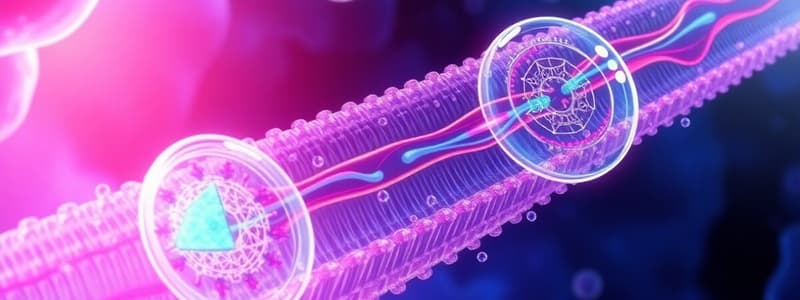Podcast
Questions and Answers
What distinguishes primary active transport from secondary active transport?
What distinguishes primary active transport from secondary active transport?
- Secondary active transport does not use protein pumps.
- Only primary active transport requires energy.
- Primary active transport moves substances against their gradient independently. (correct)
- Secondary active transport only occurs in conjunction with other substances. (correct)
Which mechanism is specifically responsible for the secretion of proteins synthesized within the cell?
Which mechanism is specifically responsible for the secretion of proteins synthesized within the cell?
- Exocytosis (correct)
- Endocytosis
- Pinocytosis
- Phagocytosis
Which statement correctly describes a characteristic of simple diffusion?
Which statement correctly describes a characteristic of simple diffusion?
- Requires protein carriers for transport of substances.
- Can be saturated when all available channels are occupied.
- Allows passage of substances from high to low concentration without energy. (correct)
- Involves energy input to move molecules against a concentration gradient.
What can be concluded about the transport mechanisms across cell membranes?
What can be concluded about the transport mechanisms across cell membranes?
Which of the following best describes the role of the Sodium-Potassium Pump?
Which of the following best describes the role of the Sodium-Potassium Pump?
Endocytosis can be categorized into which two types?
Endocytosis can be categorized into which two types?
Which of the following substances would most likely utilize facilitated diffusion for membrane transport?
Which of the following substances would most likely utilize facilitated diffusion for membrane transport?
Which of the following best describes active transport mechanisms?
Which of the following best describes active transport mechanisms?
In secondary active transport, how can the driving substance be transported?
In secondary active transport, how can the driving substance be transported?
Which mechanism would likely transport a non-polar molecule across the lipid bilayer?
Which mechanism would likely transport a non-polar molecule across the lipid bilayer?
Flashcards
Active Transport
Active Transport
The movement of a substance from a region of lower concentration to a region of higher concentration, requiring energy and a carrier protein.
Primary Active Transport
Primary Active Transport
A type of active transport where energy is directly consumed to move a substance against its concentration gradient. This typically involves protein pumps.
Secondary Active Transport
Secondary Active Transport
A type of active transport where the movement of one substance down its concentration gradient provides the energy to move another substance against its gradient. This can be symport (same direction) or antiport (opposite direction).
Exocytosis
Exocytosis
Signup and view all the flashcards
Endocytosis
Endocytosis
Signup and view all the flashcards
Simple diffusion
Simple diffusion
Signup and view all the flashcards
Facilitated diffusion
Facilitated diffusion
Signup and view all the flashcards
Tmax
Tmax
Signup and view all the flashcards
Cell membrane
Cell membrane
Signup and view all the flashcards
Study Notes
Cell Membrane Transport Mechanisms
- Cell membranes are semi-permeable. They allow the passage of lipid-soluble substances but prevent water- and water-soluble ones.
- Proteins embedded in the membrane (integral or peripheral) act as channels, carriers, pumps, enzymes, receptors, etc. and facilitate the passage of water and water-soluble substances.
- Transport mechanisms are classified as passive or active.
Passive Transport
- Passive transport does not require energy.
- Mechanisms within passive transport include:
- Simple diffusion
- Facilitated diffusion
- Others
Simple Diffusion
-
Simple diffusion is the movement of a substance from a region of higher concentration to a region of lower concentration (down its concentration gradient or electrical gradient).
-
Energy is not needed.
-
Protein carriers are not needed.
-
It follows Fick's law of diffusion. This law describes the rate of diffusion of a substance across a membrane
- J = -DA*(ΔC/ΔX). Where:
- J = net flux of solute particles (or diffusing tendency)
- D = Diffusion coefficient
- A = surface area available for diffusion
- ΔC = difference in concentration
- ΔX = thickness
- J = -DA*(ΔC/ΔX). Where:
-
Examples include diffusion of lipid-soluble substances, gases like O2 and CO2, and other non-polar substances.
-
Certain substances diffuse directly or through protein channels passively. This is sometimes considered facilitated diffusion.
Facilitated Diffusion
- Facilitated diffusion differs from simple diffusion in that protein carriers are needed.
- It has a maximum rate of transport (Tmax) that depends on the number of carriers.
- The maximum rate is reached when all the carriers are saturated.
- Examples include the transport of glucose and amino acids in the kidney and intestine through the basolateral membrane using GLUT and SGLT protein carriers.
Active Transport
- Active transport requires energy.
- Mechanisms within active transport include:
- Primary active transport
- Secondary active transport
- Exocytosis
- Endocytosis
Primary Active Transport
- A substance is transported against its chemical or electrical gradient, with energy consumption and with a carrier protein.
- Examples include the sodium-potassium pump with the use of ATP.
Secondary Active Transport
- A substance is transported against its gradient in association with another substance transported down its gradient.
- The transport may occur in the same direction as the driving substance (symport or co-transport) or in the opposite direction (antiport).
- Examples include co-transport (e.g., glucose) and antiport (e.g., hydrogen).
Exocytosis
- Exocytosis is the process of exporting substances from the cell. A granule or vesicle moves to the cell membrane, its membrane fuses with the cell membrane, the area of fusion breaks down, and the contents of the granule or vesicle are released outside.
- Important for secretion of proteins synthesized within the cell
Endocytosis
- Endocytosis is the process of importing substances into the cell, which is the reverse of exocytosis.
- Two main types
- Phagocytosis: For solid substances, like bacteria..
- Pinocytosis: For soluble substances.
Studying That Suits You
Use AI to generate personalized quizzes and flashcards to suit your learning preferences.
Related Documents
Description
Test your understanding of cell membrane transport mechanisms, including the differences between passive and active transport. This quiz covers key concepts such as simple diffusion, facilitated diffusion, and the role of membrane proteins. Challenge yourself and deepen your knowledge of cell biology!



